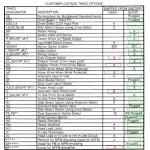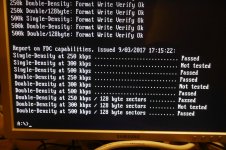Adventurer
Experienced Member
If you apply power and ground the appropriate drive select, you should get the LED. Otherwise, nothing should happen, assuming that you have the correct pullups installed.
Thanks, got it sorted out - 5V power supply ceased to exist, so installed a new one. Drive setup is currently like this:

The differences from standard are:
Could not find trace 5E, not from the picture, it is either not connected or permanent trace without jumpers
Drive select set to DS2
Sector output set to 850 (851 was waiting for hard sectored floppy)
Allow write when write protected
Could not find trace M anywhere, it is either not connected or a permanent trace without jumpers
Drive input is terminated with 7 1K resistors
Every other jumper is set as standard, according to the picture - either connected or free
Now:
286 PC
The 286 is able to read/write in limited formats due to FDC incompatibility, but it works, there is a single drive A: in BIOS now
Intel Celeron 2.6
It does recognise drive as A: on switching on, drive access light goes on, solenoid makes a click (no seek yet), but, after saving changes to BIOS, it reboots, and shows "Error 601 floppy controller", and drive A: is removed from BIOS. Can repeat as many times I want:
First time:
BIOS recognises the drive, access light and solenoid engages, BIOS reboots - and drive A: is lost
What am I missing, and why it works properly on a 286?


![P1001417[1].jpg P1001417[1].jpg](https://forum.vcfed.org/data/attachments/28/28569-d587290ea5d3d4dc99ebed46c2fbb0de.jpg)
![P1001416[1].jpg P1001416[1].jpg](https://forum.vcfed.org/data/attachments/28/28570-5958273a9a91cc38e2c0262b29216d1c.jpg)
![P1001422[1].jpg P1001422[1].jpg](https://forum.vcfed.org/data/attachments/28/28571-b4bd41e6c1a3657e665696345d17d301.jpg)
![P1001415[1].jpg P1001415[1].jpg](https://forum.vcfed.org/data/attachments/28/28572-fa812b417e5fd8c61b2ce0e3039988ab.jpg)
![P1001432[1].jpg P1001432[1].jpg](https://forum.vcfed.org/data/attachments/28/28591-ec089f7549677a36bea5065668c89c12.jpg)
![P1001431[1].jpg P1001431[1].jpg](https://forum.vcfed.org/data/attachments/28/28592-40933941e2581a9d91e4b34a70bd48ac.jpg)

